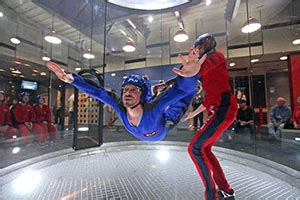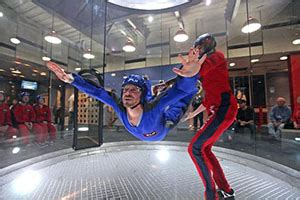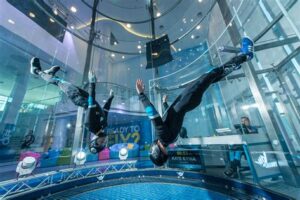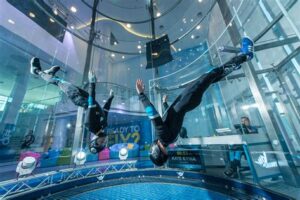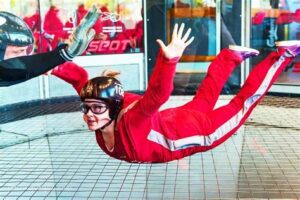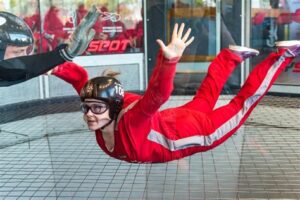Table of Contents
Indoor skydiving gear is essential for experiencing the thrill of freefall in a controlled environment. From specially designed jumpsuits to helmets and goggles, this equipment ensures safety and enhances the overall skydiving experience. Discover the must-have gear for indoor skydiving and prepare to defy gravity with confidence and style.
Indoor skydiving is an exhilarating sport that allows you to experience the thrill of freefall without jumping out of a plane. But just like any extreme activity, having the right gear is essential for a safe and enjoyable experience. Whether you are a seasoned indoor skydiver or a first-time flyer, understanding and using the proper equipment is crucial. In this article, we will guide you through the world of indoor skydiving gear, from helmets to jumpsuits, providing you with all the necessary information to make the most out of your next gravity-defying adventure.
Introduction
Welcome to the world of indoor skydiving! Whether you are a seasoned skydiver looking to practice your skills or a thrill-seeker eager to experience the sensation of freefall, indoor skydiving is an exhilarating adventure. In order to enjoy this unique activity safely and comfortably, it is essential to understand the gear required. In this article, we will guide you through the essential indoor skydiving gear and provide you with all the necessary instructions to make your experience unforgettable.
The Wind Tunnel
What is a Wind Tunnel?
A wind tunnel is the heart of indoor skydiving. It is a vertical chamber with powerful fans that generate a controlled upward airflow, mimicking the sensation of freefall experienced during outdoor skydiving. The wind tunnel provides a safe environment for participants to simulate skydiving and practice various maneuvers.
How to Use the Wind Tunnel
Before entering the wind tunnel, make sure to remove any loose items, such as jewelry or hats, that may be blown away by the strong airflow. Listen attentively to the instructor’s briefing, which will cover body positioning, hand signals, and safety protocols. Once inside the tunnel, maintain a stable body position (belly down, arms extended forward) and adjust your body angle to control your altitude. Remember to relax and enjoy the sensation of floating in the air!
The Flight Suit
Importance of a Flight Suit
A flight suit is a crucial piece of gear for indoor skydiving. It not only adds a touch of authenticity to your experience but also provides practical benefits. The flight suit helps streamline your body, reducing drag and allowing you to maintain stability in the wind tunnel. Additionally, it protects your clothing from potential wear and tear caused by the strong airflow.
Selecting the Right Flight Suit
When choosing a flight suit, opt for one that fits snugly but still allows freedom of movement. Look for suits made from durable materials that can withstand the rigors of indoor skydiving. Some flight suits even feature grippy surfaces on the arms and legs to facilitate better control during maneuvers. Consult with the staff at the indoor skydiving facility for recommendations on finding the perfect fit.
The Helmet
Why Wear a Helmet?
Although you won’t be jumping out of an airplane, wearing a helmet is still essential for safety purposes during indoor skydiving. The strong airflow in the wind tunnel can cause unexpected turbulence, and the helmet provides protection for your head against any potential collisions or impacts.
Choosing the Right Helmet
Ensure your helmet fits snugly but comfortably. It should not obstruct your vision or impede your ability to hear instructions. Look for helmets specifically designed for skydiving or extreme sports, as they are built to withstand higher impact forces. Double-check the helmet’s safety certifications to ensure it meets industry standards.
Eye Protection
Protecting Your Eyes
As you soar through the wind tunnel, it is crucial to shield your eyes from the strong airflow and potential debris. Skydiving goggles or protective eyewear are designed to keep your vision clear and protect your eyes from any foreign objects that may be present in the wind tunnel.
Choosing the Right Goggles
Opt for goggles that offer a secure fit and have anti-fog properties to prevent condensation caused by the temperature difference between the tunnel and your body. Look for goggles with a wide field of vision to enhance your overall experience. Consult with the facility staff to ensure the goggles are compatible with your helmet.
Clothing and Footwear
Comfort and Mobility
When it comes to clothing and footwear for indoor skydiving, prioritize comfort and mobility. Wear athletic clothing that allows freedom of movement, such as leggings or athletic shorts, along with a breathable shirt. Avoid loose clothing that may flap around in the wind tunnel. For footwear, select well-fitted athletic shoes with non-marking soles to ensure stability.
Avoid Jewelry and Accessories
It is crucial to remove any jewelry, watches, or accessories before entering the wind tunnel. These items can be hazardous when exposed to the strong airflow and may cause injury to yourself or others. Store them safely in a secure locker or with a trusted companion while you enjoy your indoor skydiving session.
Conclusion
Indoor skydiving is an incredible adventure that allows you to experience the thrill of freefall in a controlled environment. Understanding and utilizing the appropriate gear is essential for your safety and enjoyment during this exhilarating activity. Remember to follow the instructions provided by the facility staff, and don’t forget to relax, have fun, and embrace the sensation of flying! So, gear up, prepare for an unforgettable experience, and let the wind take you to new heights!
Indoor Skydiving Gear – Usage Instructions
Helmet:
Ensure the helmet fits snugly on your head, with no loose straps or gaps around the edges. Fasten the chinstrap securely before entering the facility to guarantee your safety during the skydiving experience. Remember to check the helmet for any signs of damage or wear prior to use.
Flight Suit:
Put on the flight suit by sliding your legs through the designated pant legs and your arms through the sleeves. Zip up the front and use the Velcro straps to secure the suit tightly around your body. Avoid any loose-fitting garments underneath to prevent interference with your movement while flying.
Goggles:
Carefully position the goggles over your eyes, ensuring a clear field of vision and a comfortable fit. Ensure the goggles are securely strapped around your head, providing protection from wind and debris during the indoor skydiving session. Adjust the strap length to fit snugly and avoid obstruction during your flight.
Earplugs:
Insert the provided earplugs into each ear canal before starting your skydiving experience. This will help reduce the noise levels produced by the wind, ensuring a more comfortable and enjoyable flight. Make sure the earplugs fit correctly to prevent any discomfort or risk of them falling out.
Gloves:
Slide your hands into the gloves, ensuring they fit snugly but still allow a full range of movement. The gloves should offer a good grip and protection against any friction created while flying. Make sure they are securely fastened at the wrist for optimal safety.
Shoes:
Put on a pair of closed-toe athletic shoes that fit well and offer proper support. Avoid footwear with loose laces or open toes to prevent any accidents or discomfort during the experience. Ensure the shoes are securely tied to minimize any risk of tripping or slipping during the indoor skydiving session.
Flight Chamber:
When entering the flight chamber, ensure all loose objects, such as watches, jewelry, or loose clothing, are removed. Stand on the designated launch area and follow instructions from the flight instructor regarding body position, hand signals, and maintaining balance while flying. Stay alert, focused, and maintain a proper flying posture throughout the session.
Safety Harness:
Before entering the flight chamber, make sure the safety harness is properly secured around your waist and fastened tightly. Familiarize yourself with the release mechanism, location of emergency stop buttons, and any additional safety features unique to the specific harness being used. Communicate with the instructor if any adjustments or assistance are required to ensure a safe and enjoyable indoor skydiving experience.
Point of View: Indoor Skydiving Gear Use Instructions
Voice: Informative and clear
- The use instructions for indoor skydiving gear aim to provide a comprehensive guide on how to properly use the equipment.
- The voice used in these instructions is informative, ensuring that users understand each step clearly.
- The tone is professional yet friendly, making the user feel comfortable and confident in following the instructions.
- It is important to use simple and concise language to avoid confusion or misunderstanding.
- Technical terms are explained and defined to ensure that even beginners can understand the instructions.
Voice: Safety-conscious and cautious
- Safety is a top priority when it comes to using indoor skydiving gear, and the instructions reflect this by emphasizing the importance of following safety procedures.
- The tone of the instructions conveys a sense of caution, reminding users to be aware of potential risks and to take necessary precautions throughout the entire process.
- Clear warnings are provided to ensure that users understand the potential dangers associated with improper use of the gear.
- The instructions encourage users to seek professional guidance or assistance when unsure about any aspect of using the gear.
Voice: Encouraging and motivating
- The tone of the instructions is encouraging, motivating users to embrace the experience of indoor skydiving.
- Instructions include positive reinforcement and words of encouragement to help users build confidence in themselves and their ability to handle the gear.
- Phrases such as You’ve got this! and Enjoy the thrill of indoor skydiving! are used to uplift the user’s spirits and create a positive atmosphere.
- Reassurances are given to users, highlighting that with practice and adherence to the instructions, they will be able to master the gear and enjoy the exhilarating experience of indoor skydiving.
In conclusion, the point of view of indoor skydiving gear use instructions should be informative, safety-conscious, and encouraging. By maintaining a clear and concise voice while emphasizing safety measures and instilling confidence in users, these instructions can effectively guide individuals in using the gear correctly and enjoying the thrilling activity of indoor skydiving.
Thank you for visiting our blog and taking the time to learn about indoor skydiving gear. We hope that this article has provided you with valuable insights and information on how to choose the right gear for your indoor skydiving adventures. Before we conclude, allow us to summarize the main points discussed throughout this blog post.
Firstly, it is crucial to prioritize safety when selecting indoor skydiving gear. Your safety should always be the top priority, so investing in high-quality gear is essential. Look for helmets, goggles, and jumpsuits that are specifically designed for indoor skydiving. These items should fit properly, provide adequate protection, and offer maximum comfort during your flights.
Secondly, consider the importance of functionality and performance. Indoor skydiving gear should enable you to have full control and maneuverability while in the wind tunnel. Look for jumpsuits made from breathable materials that allow for easy movement. The design should be aerodynamic to enhance your flight experience. Additionally, ensure that the helmet provides clear visibility and the goggles are anti-fog to avoid any hindrance to your vision.
Lastly, don’t forget about style and personal preference. While safety and functionality are crucial, it’s also important to feel confident and comfortable in your gear. Choose colors and designs that resonate with your personality and make you feel excited for your indoor skydiving sessions. Many manufacturers offer a variety of options to suit different styles and preferences, so take the time to explore and find gear that truly reflects who you are.
In conclusion, selecting the right indoor skydiving gear is a vital aspect of ensuring a safe, enjoyable, and thrilling experience. Remember to prioritize safety, focusing on high-quality gear that fits well and provides adequate protection. Consider functionality and performance, looking for gear that enables optimal control and maneuverability. And finally, don’t forget about style and personal preference, as feeling confident and comfortable in your gear can enhance your overall indoor skydiving experience. We hope this article has been helpful, and we wish you the best of luck in all your future indoor skydiving adventures!
.
People Also Ask about Indoor Skydiving Gear:
-
What gear do you need for indoor skydiving?
For indoor skydiving, you will typically need the following gear:
- A jumpsuit: This helps with aerodynamics and protects your clothing from windburn.
- A helmet: It is essential for safety and to protect your head during the flight.
- Goggles: These protect your eyes from wind and debris.
- Earplugs: They help reduce noise levels in the wind tunnel.
- Gloves: Some people prefer wearing gloves for added grip and protection.
-
Can you bring your own gear for indoor skydiving?
In most cases, indoor skydiving facilities provide all the necessary gear you need for your flight. However, if you have your own jumpsuit, helmet, or goggles, you can usually bring them along and use them if they meet the facility’s safety standards.
-
How do you choose the right size jumpsuit for indoor skydiving?
To choose the right size jumpsuit for indoor skydiving, you should consider your body measurements, particularly your height and weight. Different manufacturers may have slightly different sizing charts, so it’s best to consult the specific sizing guide provided by the jumpsuit manufacturer or seek guidance from the indoor skydiving facility staff.
-
Are there any weight restrictions for indoor skydiving?
Yes, there are usually weight restrictions for indoor skydiving due to safety reasons. The weight limit varies depending on the specific wind tunnel and equipment used. It is advisable to check the weight restrictions of the facility beforehand to ensure you meet their requirements.
-
Do you need previous skydiving experience for indoor skydiving?
No, you do not need any previous skydiving experience for indoor skydiving. Indoor skydiving is a safe and controlled environment where beginners can experience the thrill of skydiving without jumping out of an airplane. Qualified instructors will guide you through the process and provide necessary training before your flight.

